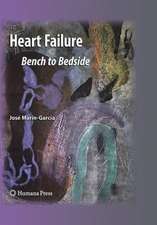Functional Morphology of the Endocrine Heart
Editat de W. -G Forssmann, W. Scheuermann, J. Alten Limba Engleză Paperback – 29 feb 2012
Preț: 645.09 lei
Preț vechi: 679.05 lei
-5% Nou
Puncte Express: 968
Preț estimativ în valută:
123.46€ • 128.55$ • 104.34£
123.46€ • 128.55$ • 104.34£
Carte tipărită la comandă
Livrare economică 06-12 martie
Preluare comenzi: 021 569.72.76
Specificații
ISBN-13: 9783642724343
ISBN-10: 3642724345
Pagini: 239
Ilustrații: XVI, 239 p. 39 illus.
Dimensiuni: 156 x 244 x 20 mm
Ediția:1989
Editura: Steinkopff
Colecția Steinkopff
Locul publicării:Heidelberg, Germany
ISBN-10: 3642724345
Pagini: 239
Ilustrații: XVI, 239 p. 39 illus.
Dimensiuni: 156 x 244 x 20 mm
Ediția:1989
Editura: Steinkopff
Colecția Steinkopff
Locul publicării:Heidelberg, Germany
Public țintă
Professional/practitionerCuprins
Embryology of the endocrine heart.- Morphological review: immunohistochemistry and ultrastructure of the endocrine heart.- Evidence for the existence of cardiac hormones in the conductive system of the mammalian heart.- Catecholamine-containing granules in cardiac chromaffin cells as compared with atrial granules.- Seasonal changes of the endocrine heart.- Storage and secretion of atrial natriuretic peptide (ANP) by cultured atrial and ventricular cells from the neonatal rat.- Combined quantitative morphological and biochemical study on atrial granules (AG).- Immunohistochemical evidence for a neurosecretory and neurotransmitter function of CDD/ANP-immunoreactive neurons in molluscs.- Dual distribution of cardiac hormones (CDD/ANP) in heart and brain of vertebrates.- Steroid hormones and the endocrine heart.- Biochemistry of cardiac hormones.- The physiological importance of Atrial Natriuretic Peptide.- Pharmacology of the cardiac endocrine system.- Sites of action of ANF as a circulating hormone.- Pathomorphology of the endocrine heart.- Endocrine heart in experimental cardiomyopathy.- Atrial natriuretic peptide in man.- The behaviour of CDD (cardiodilatin) during graded exerciseon a bicycle ergometre.- Plasma concentrations of atrial natriuretic peptide ?-h- ANP1–28) during exercise and relationship to hemodynamic parameters in man.- Plasma atrial natriuretic factor responses to opiates.- Atrial natriuretic peptide in term newborn infants.- Effect of ANP bolus injection on endocrine and renal regulation in patients with liver cirrhosis and ascites.- Atrial natriuretic peptide (?-h-ANP) in 157 children with congenital heart diseases.- Receptor binding of cardiac hormones to dog kidney with congestive heart failure.- Characterization of the ANF system in patientswith cirrhosis of the liver.- The effect of human atrial natriuretic peptide on renal and cardiovascular responses to insulin-induced hypoglycemia in healthy man.







